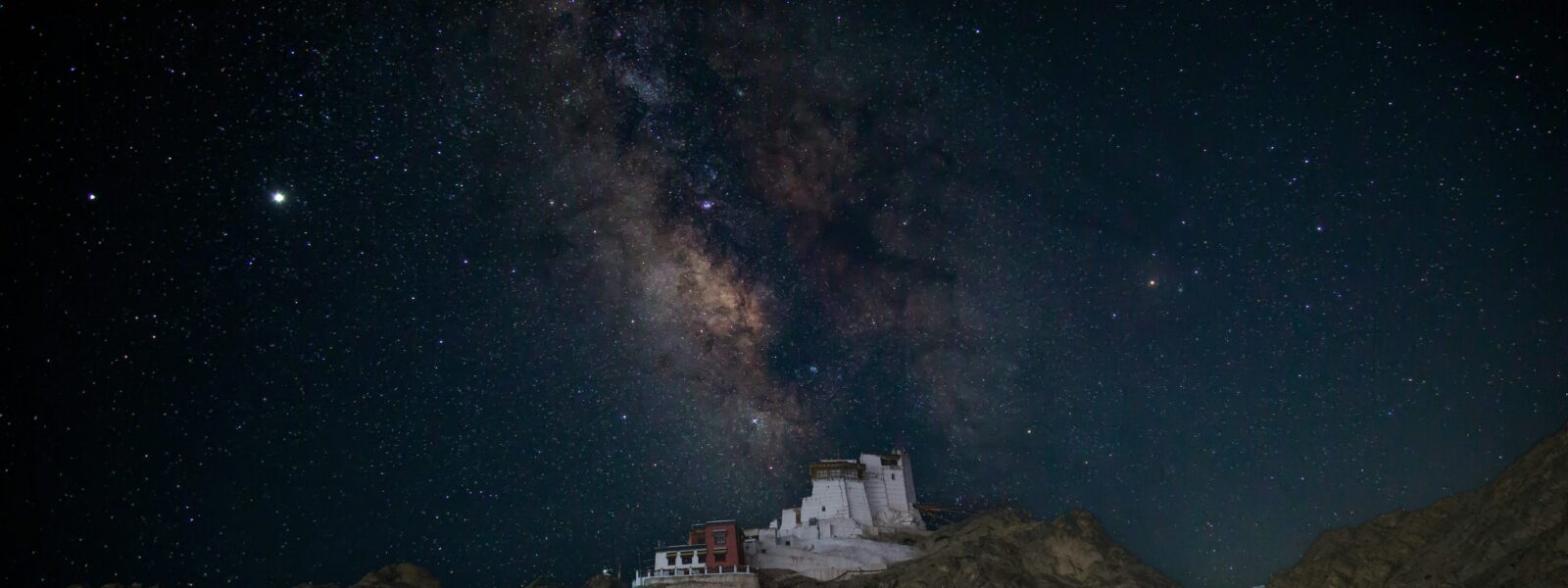When the Night Becomes Memory Over the Indus
By Elena Marlowe
Prologue — The River Beneath the Stars
The Indus as a Mirror of the Sky
Before dawn touches Ladakh, the Indus lies still — a ribbon of silver shadow running between the bones of the Himalayas. Above it, constellations drift in silence. Their light, older than memory, trembles upon the water as though the universe itself were pausing to remember. Traveling through Ladakh at night is not merely a journey through geography; it is a crossing of eras, a dialogue between air, starlight, and breath. The higher one climbs, the more transparent the distance between the visible and the invisible becomes.
In these valleys, astronomy and intimacy merge. The people of Hanle, Tso Moriri, and Nubra live beneath one of the clearest skies on Earth, where constellations in Ladakh are not distant figures of mythology but living companions of the night. It is here that one learns what stargazing in Ladakh truly means — a practice of stillness, of listening to the cosmos without demand, without conquest.
I. The Geography of Stillness
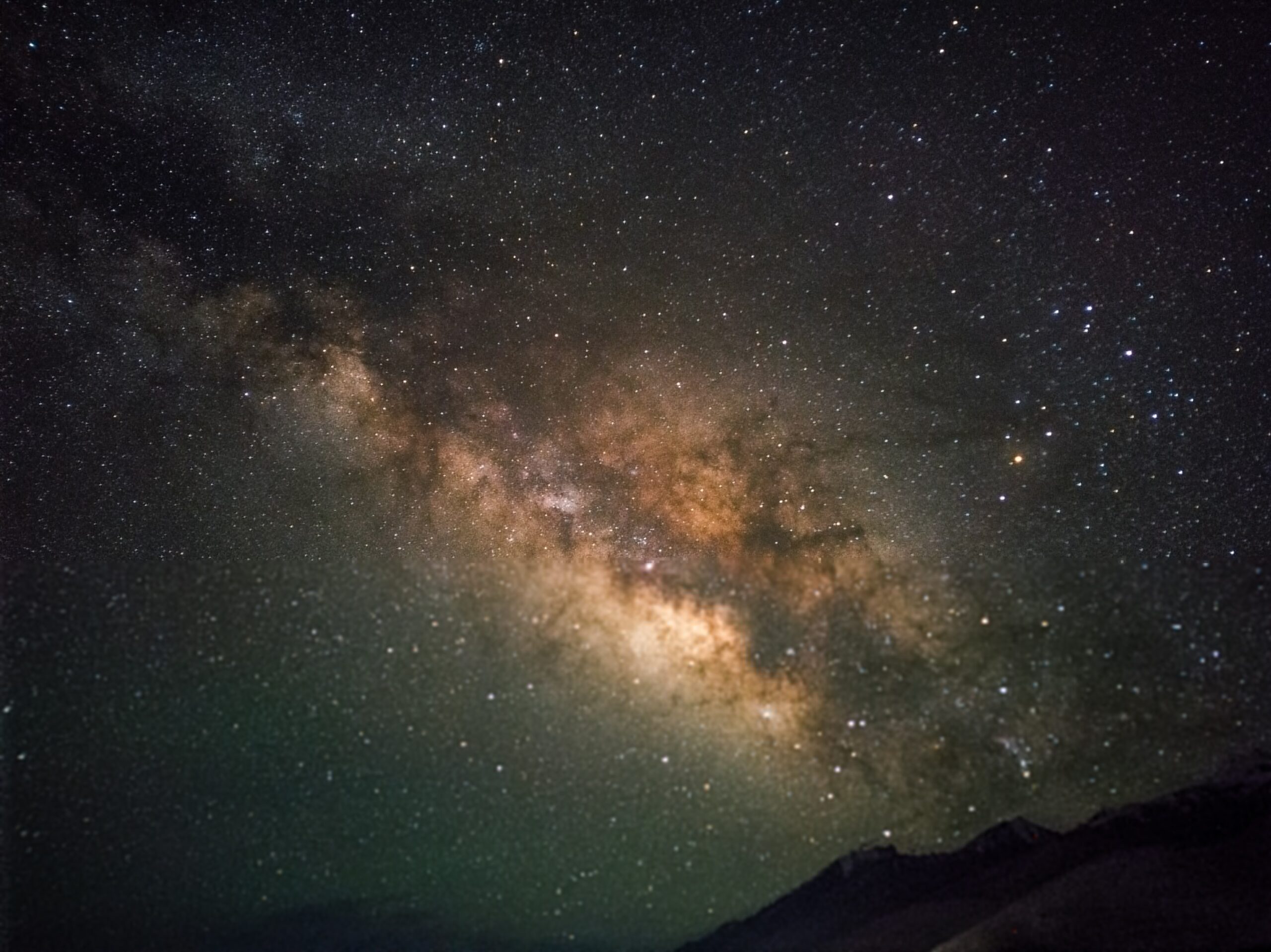
Where Altitude Meets Clarity
At 4,500 meters, silence has texture. Air becomes thin enough to see through, and the horizon widens until thought itself feels too small to contain it. The night sky in Ladakh is not black; it is a gradation of deep indigo and silver dust. At Hanle Dark Sky Reserve — one of the highest observatories in the world — the Milky Way over Ladakh stretches like a luminous river, echoing the flow of the Indus below. Here, light pollution is minimal, and the human heartbeat seems to sync with the pulse of the universe.
The body responds differently at this altitude. Breathing is deliberate, like a ritual. Each inhale draws in a million particles of star-born carbon; each exhale returns a trace of the self to the sky. The Indus valley night sky does not ask to be photographed — it asks to be remembered. When eyes adjust to the darkness, they begin to perceive the faint outlines of constellations invisible elsewhere: delicate fragments of cosmic script suspended in Himalayan air.
The Architecture of Silence
The monasteries of Diskit and Hemis seem less like human structures than extensions of the surrounding rock. From their terraces, one can watch the constellations rise over the ridges — Orion, Taurus, Gemini — the same stars that guided caravans centuries ago. Yet here, astronomy becomes philosophy. The sky above Ladakh feels closer not because of elevation, but because humility becomes possible at this scale. Under such immensity, the mind unravels into quiet recognition: we are not observers of the cosmos; we are participants in its remembering.
II. The Constellations That Cross the Indus

Winter — Orion and the Mirror of Ice
In winter, when the air freezes into crystal breath, Orion the Hunter rises over the frozen Indus like a silent pilgrim. His belt of three stars aligns precisely with the flow of the river, tracing a celestial map of ancient trade routes. Nearby, the Pleiades cluster glimmers — a soft constellation known in Ladakh’s oral traditions as “the sisters of wind.” Taurus follows, carrying with it the story of strength and endurance through the long Himalayan nights. The stargazing in Ladakh during winter feels both intimate and infinite: each star sharp enough to cast a shadow on snow.
Spring — Leo’s Patience and Virgo’s Arrival
By April, the horizon warms, and Leo emerges, reclining above the Indus valley. His bright heart, Regulus, becomes a guide for travelers crossing between Leh and Alchi. Later comes Virgo, her blue-white light symbolizing renewal and harvest. To the people of the Changthang plateau, her presence coincides with the thawing of lakes and the return of migratory birds. The Himalayan night photography during this season captures more than beauty — it captures transition, the subtle shift from silence to movement, from survival to anticipation.
Summer — The Milky Way and the Breath of the Plateau
In summer, the Milky Way over Ladakh rises like a silver arch from horizon to horizon. At Tso Moriri, the galaxy seems to spill into the lake, blurring the boundary between water and starlight. Constellations such as Scorpius, Lyra, and Aquila dominate the heavens, forming the Summer Triangle above the Changthang plains. This is the time of pilgrimages and high passes, when even the sky feels closer to the earth. Each photograph taken here becomes an act of gratitude — the stars so clear that they appear as lanterns suspended from invisible threads.
Autumn — Pegasus, Andromeda, and the Return of Stillness
As the winds turn colder, Pegasus soars over Hanle, marking the entrance to the season of quiet. The Andromeda Galaxy — visible even to the naked eye — reminds travelers of the unfathomable distance between galaxies and yet the intimacy of being able to see it. Cassiopeia gleams in the northern sky, her W-shaped crown tilting over the monastery walls. Autumn is when the rhythm of the highlands slows once again, and the constellations take on the role of storytellers, recounting the cycles of return and release.
III. Sky as Cultural Memory
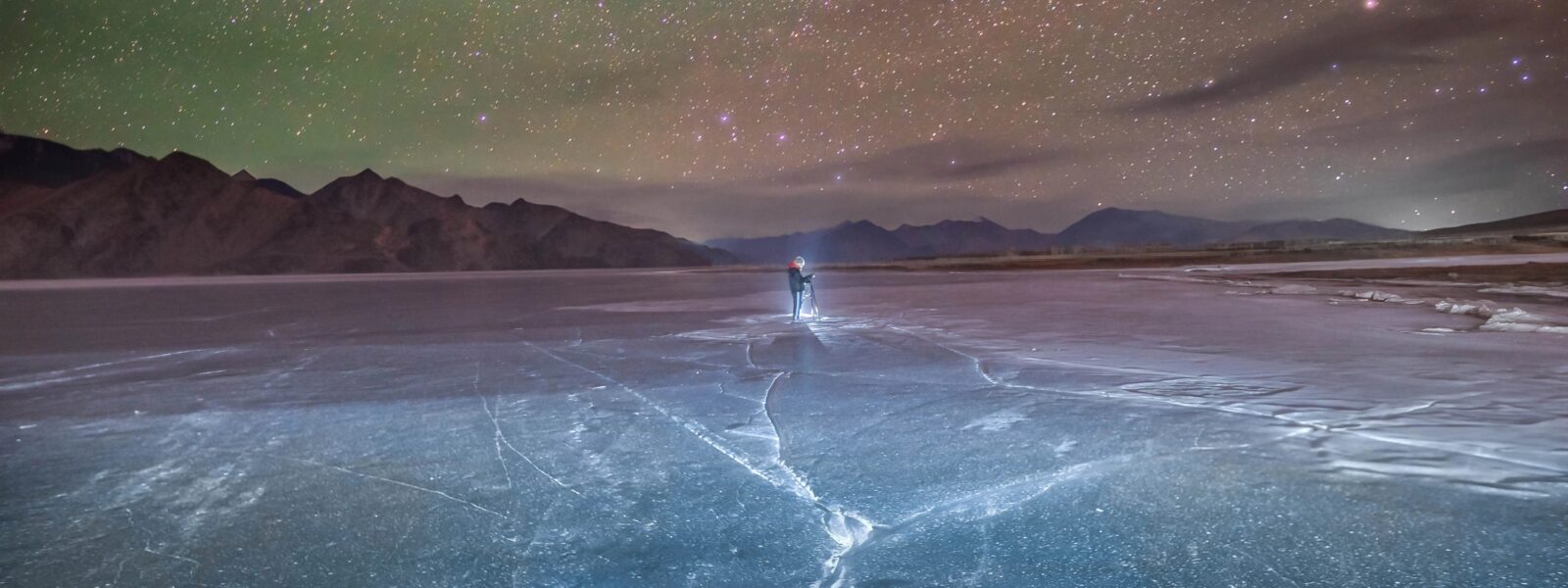
Stars as the Language of Compassion
In Ladakh’s monasteries, the stars are regarded as “eyes of compassion.” The monks say that to gaze at the night sky is to be seen by it. Astronomy here is less about observation and more about relationship. The constellations visible from Hanle are interpreted not as hunters or heroes but as symbols of interconnection. The Milky Way becomes “the Path of Souls,” guiding both the living and the departed across the infinite. The cosmic heritage of India lies not in its temples alone but in its unbroken dialogue with the heavens.
Each village has its own mythology of light. In Nubra, the rising of Orion signals the start of the prayer season; in Turtuk, the appearance of Scorpius marks the time to mend roofs before the wind changes. The Himalayan constellations are woven into agricultural rhythm, spiritual practice, and even architectural alignment. In a place where calendars once meant little, it is the stars that have long measured the pulse of life.
The Night as Archive
Every photograph of the Ladakh night sky is a fragment of an archive that began long before humans. The photons captured by camera sensors began their journey before rivers were born. Yet even as modern travelers seek astrophotography, they become part of a continuum — witnesses of a memory that transcends personal experience. The constellations are not stories we tell about the sky; they are the sky’s stories about us.
IV. Breath, Altitude, and Intimacy
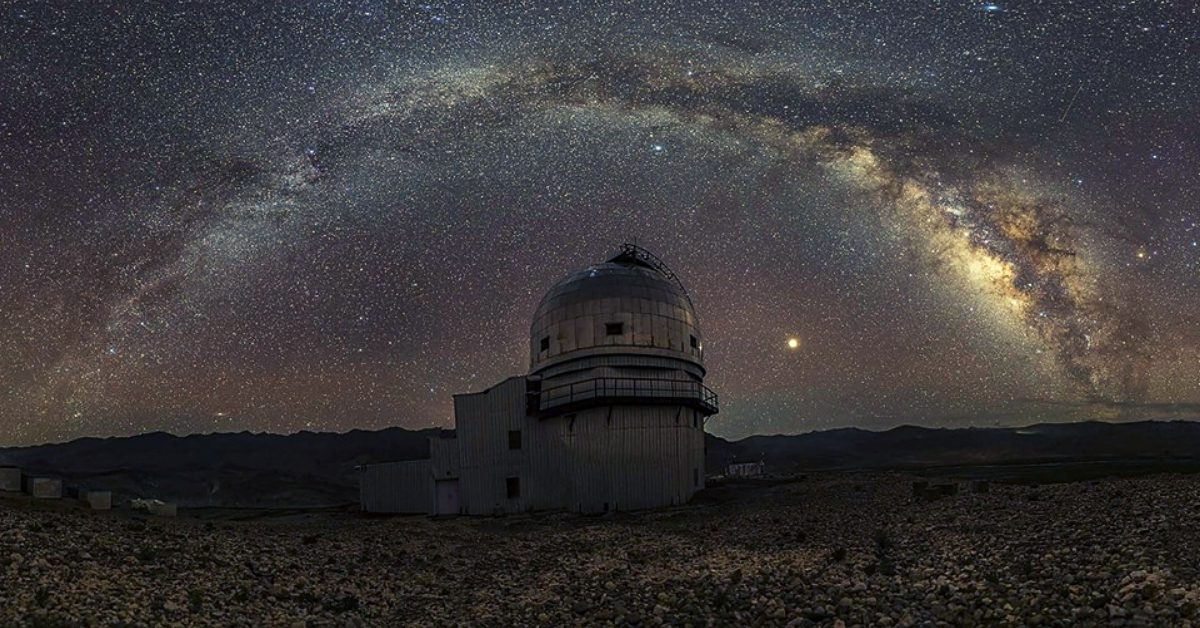
The Physiology of Wonder
At altitude, wonder is not abstract. The thin air alters perception, slowing thought and heightening sensation. Breathing beneath the dark sky of Ladakh becomes an act of devotion — a rhythm shared with the mountains. Each heartbeat resonates through the chest like a quiet drum against infinity. The body becomes porous to the atmosphere, translating light into pulse. Here, the astronomy travel in India finds its purest form: not data collection, but awakening.
Listening to Light
There are moments when the silence between two stars feels audible. The eyes adjust, the mind softens, and something wordless begins to move through the body — a quiet recognition that seeing is also being seen. To witness the constellations crossing the Indus is to participate in a living ceremony of memory. The stars, unchanged for millennia, do not merely remind us of eternity; they teach us the art of remaining.
“In Ladakh, the night does not fall — it deepens until thought becomes starlight.”
V. The Future of the Night
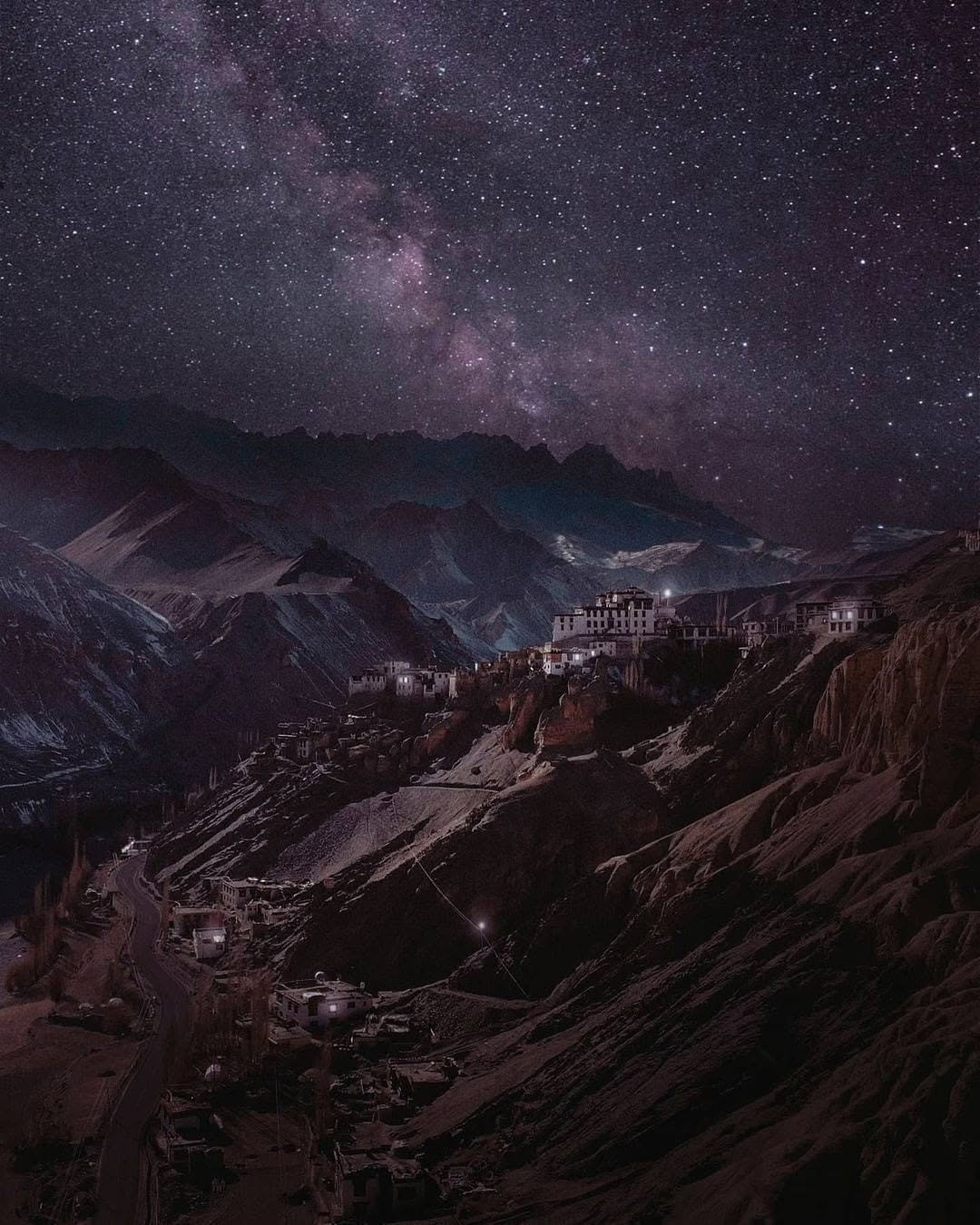
Preserving the Dark Sky
Few places on Earth still allow the naked eye to perceive the full arch of the Milky Way. As development reaches deeper into the Himalayas, preserving Ladakh’s dark sky heritage becomes a moral responsibility. Light pollution is not only an environmental issue but a cultural one. Each unnecessary lamp erases part of humanity’s oldest story — the dialogue between ground and galaxy. Sustainable travel in Ladakh must include protecting the silence above. The future of eco-astrotourism in the Himalayas depends on restraint: traveling softly, lighting less, remembering more.
Constellations as Common Ground
The sky belongs to no nation. Above borders, the constellations move freely — silent diplomats of light. The same Orion that watches over the Indus also shines over the Andes and the Alps. When travelers come to Ladakh, they are not just crossing terrain; they are entering a shared cosmos. In that realization lies a quiet revolution: to look up together is to remember that we were never separate.
FAQ
What are the best months for stargazing in Ladakh?
The clearest skies are from October to March, when the atmosphere is cold and dry. During these months, the Milky Way and constellations like Orion and Taurus are most vivid above the Indus valley.
Where is the best place for astrophotography in Ladakh?
Hanle Dark Sky Reserve, near the Changthang plateau, offers exceptional visibility and minimal light pollution. Its altitude and isolation make it one of the premier sites for astrophotography in Asia.
Can visitors see the Milky Way with the naked eye in Ladakh?
Yes. At high-altitude locations such as Tso Moriri and Nubra Valley, the Milky Way appears as a luminous band stretching across the sky, visible even without telescopes or special equipment.
How does altitude affect the visibility of stars?
Thinner air reduces atmospheric scattering, allowing starlight to reach the eye with greater clarity. This is why high-altitude regions like Ladakh offer unparalleled night-sky visibility compared to lower elevations.
Conclusion — The Night That Remembers
When dawn finally brushes the Indus valley, the stars withdraw into memory. Yet their absence is not loss but continuation — the cosmos exhaling after a night of intimacy. Traveling through Ladakh beneath these constellations reminds us that wonder is not a distant phenomenon; it is the most human act of all. To look up is to listen. To listen is to belong.
Closing Note
In a world of noise and urgency, Ladakh’s sky invites us to return to slowness. Beneath the constellations that cross the Indus, we rediscover an ancient rhythm — the breath between light and silence, the quiet pulse that connects all who wander beneath the same remembered stars.
Her work reflects a dialogue between inner landscapes and the high-altitude world of Ladakh.

